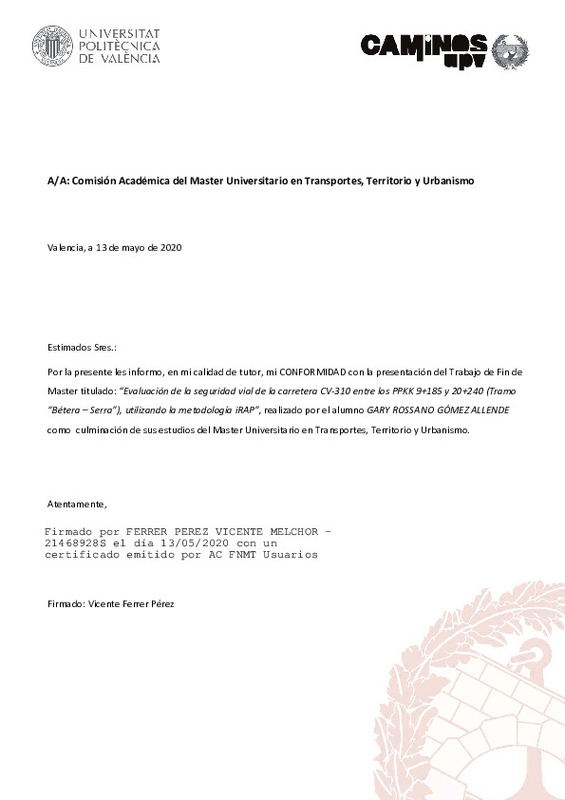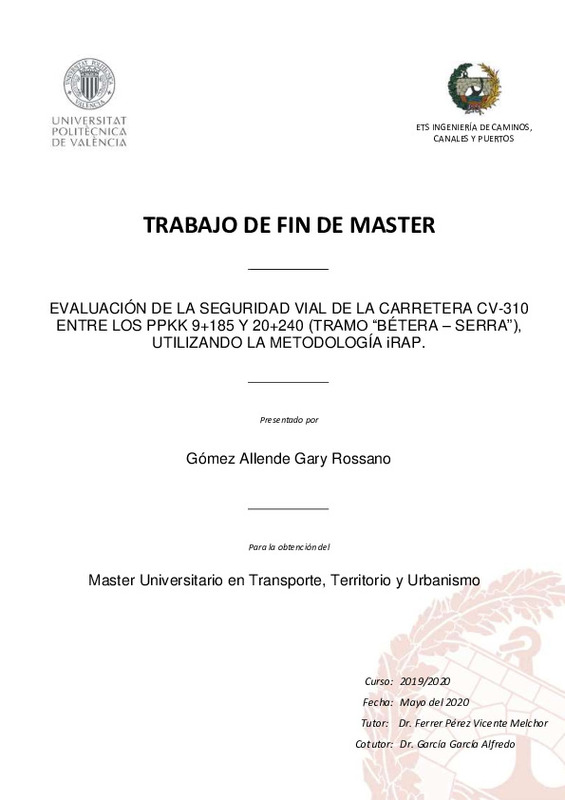JavaScript is disabled for your browser. Some features of this site may not work without it.
Buscar en RiuNet
Listar
Mi cuenta
Estadísticas
Ayuda RiuNet
Admin. UPV
Evaluación de la seguridad vial de la carretera CV-310 entre los PPKK 9+185 y 20+240 (Tramo "Bétera Serra"), utilizando la metodología iRAP
Mostrar el registro sencillo del ítem
Ficheros en el ítem
| dc.contributor.advisor | Ferrer Pérez, Vicente Melchor
|
es_ES |
| dc.contributor.advisor | García García, Alfredo
|
es_ES |
| dc.contributor.author | Gómez Allende, Gary Rossano
|
es_ES |
| dc.coverage.spatial | east=-0.43530829507292257; north=39.62795102165405; name=CV-310, 15, 46119 Nàquera, Valencia, Espanya | es_ES |
| dc.date.accessioned | 2020-07-14T15:37:59Z | |
| dc.date.available | 2020-07-14T15:37:59Z | |
| dc.date.created | 2020-05-22 | |
| dc.date.issued | 2020-07-14 | es_ES |
| dc.identifier.uri | http://hdl.handle.net/10251/147982 | |
| dc.description.abstract | [ES] A nivel mundial los accidentes en carreteras generan un gran número de fallecidos y heridos, así como también grandes pérdidas económicas, esto debido a diferentes factores como el humano, vehicular y la infraestructura. Siendo las carreteras convencionales de elevada vulnerabilidad a causa de las características de seguridad vial que presentan a lo largo de su recorrido y más aún si existe una interacción con otros usuarios que también circulan o son parte de la infraestructura viaria, como son peatones y ciclistas. Por lo que el presente estudio realizado en la provincia de Valencia, tuvo como objetivo evaluar la seguridad vial basada en la metodología proporcionada por el programa iRAP (International Road Assessment Programme), de un tramo de la carretera convencional CV-310 entre los municipios de Bétera y Serra. Dicho tramo atraviesa diferentes urbanizaciones y es considerado como una ruta ciclista. Para alcanzar el objetivo es necesario conocer datos operativos y técnicos de la carretera, es así que primeramente se realizó el análisis del diseño geométrico para obtener las características del trazado en planta, alzado y sección transversal de la vía, así también, se consideró importante para lograr el objetivo de este proyecto, haber realizado un análisis de tráfico vehicular en el tramo de carretera, teniendo en cuenta que a mayor volumen de tráfico de usuarios mayor será el riesgo de accidentes, de la misma manera se realizó el análisis de consistencia para obtener más a detalle la seguridad vial del tramo de estudio y verificar deficiencias en su trazado. Una vez obtenido los datos operativos y técnicos mencionados en el párrafo anterior se procedió a establecer el modelo del programa iRAP asentado en una inspección visual de campo grabada en video de la infraestructura viaria, se utilizó también el Street View de Google Earth integrado al software de ViDA - iRAP como herramienta de apoyo y así, de esta manera caracterizar y codificar los elementos de la vía que podrían intervenir en un accidente para determinar un cierto nivel de seguridad vial hacia ocupantes de vehículo, motociclistas, ciclistas y peatones. Como resultado de esta codificación, mediante el software VIDA ¿ IRAP se obtuvo la clasificación por estrellas de los tramos identificados en la vía (1 a 5 estrellas, siendo 1 estrella significado de ¿carretera menos segura¿; y 5 estrellas significado de ¿carretera más segura¿), es así como se tuvo una herramienta para identificar posibles tramos con riesgos de accidentes y deficiencias en calidad de seguridad vial, así como también estimar un número de muertos y lesionados graves en el tramo de estudio. Posteriormente, interpretado todos los resultados de cada procedimiento mencionado anteriormente se realizó el diagnostico de seguridad vial para conocer la problemática y de esta manera generar un plan de inversión para vías más seguras el cual consiste en proponer contramedidas con motivo de reducir la cantidad de accidentes y/o disminuir la gravedad de lesiones a consecuencia de dicho accidente. | es_ES |
| dc.description.abstract | [EN] Globally, road accidents generate a large number of deaths and injuries, as well as large economic losses, this due to different factors such as humans, vehicles and infrastructure. Being the conventional roads of high vulnerability due to the road safety characteristics that they present along their route and even more so if there is an interaction with other users who also circulate or are part of the road infrastructure such as pedestrians and cyclists. Therefore, the present study carried out in the province of Valencia, aimed to evaluate road safety based on the methodology provided by the iRAP (International Road Assessment Programme), of a section of the conventional CV-310 road between the municipalities of Bétera and Serra. This section crosses different developments and is considered as a cycling route. To achieve the objective it is necessary to know operational and technical data of the road, so first the analysis of the geometric design was carried out to obtain the characteristics of the layout in plan, elevation and cross section of the track, so it was also considered important to achieve the objective of this project to have carried out a traffic analysis of road users circulating along the section of road road, so it was also considered important to achieve the objective of this project to have carried out a traffic analysis of road users circulating along the section of road road, so it was also considered important to achieve the objective of this project to have carried out a traffic analysis of road users circulating along the section of road road , taking into account that the higher the volume of user traffic the greater the risk of accidents, in the same way the consistency analysis was performed to obtain more detail the road safety of the section of study and verify deficiencies in its layout. Once the operational and technical data referred to in the previous paragraph had been obtained, the iRAP program model was established in a video-recorded visual inspection of the road infrastructure, Google Earth's Street View integrated into the ViDA -iRAP software was also used as a support tool and thus characterize and encode the elements of the road that could intervene in an accident to determine a certain level of road safety towards vehicle occupants, motorcyclists, cyclists and pedestrians. As a result of this coding, the VIDA ¿ IRAP software obtained the star rating of the sections identified on the track (1 to 5 stars, being 1 star meaning "less safe road"; and 5 stars meaning "safer road"), is how a tool was made to identify possible sections with risks of accidents and deficiencies in road safety, as well as estimate a number of fatal and seriously injured in the section of study. Subsequently, interpreted all the results of each procedure mentioned above was carried out the diagnosis of road safety to know the problem and in this way generate an investment plan for safer routes which consists in proposing countermeasures in order to reduce the number of accidents and / or reduce the severity of injuries as a result of said accident. | es_ES |
| dc.format.extent | 0 | es_ES |
| dc.language | Español | es_ES |
| dc.publisher | Universitat Politècnica de València | es_ES |
| dc.rights | Reconocimiento - No comercial - Sin obra derivada (by-nc-nd) | es_ES |
| dc.subject | IRAP | es_ES |
| dc.subject | VIDA ¿ IRAP | es_ES |
| dc.subject | Seguridad Vial | es_ES |
| dc.subject | Clasificación por Estrellas | es_ES |
| dc.subject | Contramedidas | es_ES |
| dc.subject | Usuarios Viales. | es_ES |
| dc.subject | Road Safety | es_ES |
| dc.subject | Star Rating | es_ES |
| dc.subject | Countermeasures | es_ES |
| dc.subject | Road Users. | es_ES |
| dc.subject.classification | INGENIERIA E INFRAESTRUCTURA DE LOS TRANSPORTES | es_ES |
| dc.subject.other | Máster Universitario en Transporte, Territorio y Urbanismo-Màster Universitari en Transport, Territori i Urbanisme | es_ES |
| dc.title | Evaluación de la seguridad vial de la carretera CV-310 entre los PPKK 9+185 y 20+240 (Tramo "Bétera Serra"), utilizando la metodología iRAP | es_ES |
| dc.type | Tesis de máster | es_ES |
| dc.rights.accessRights | Abierto | es_ES |
| dc.contributor.affiliation | Universitat Politècnica de València. Departamento de Ingeniería e Infraestructura de los Transportes - Departament d'Enginyeria i Infraestructura dels Transports | es_ES |
| dc.contributor.affiliation | Universitat Politècnica de València. Escuela Técnica Superior de Ingenieros de Caminos, Canales y Puertos - Escola Tècnica Superior d'Enginyers de Camins, Canals i Ports | es_ES |
| dc.contributor.affiliation | Universitat Politècnica de València. Instituto del Transporte y Territorio - Institut del Transport i Territori | es_ES |
| dc.description.bibliographicCitation | Gómez Allende, GR. (2020). Evaluación de la seguridad vial de la carretera CV-310 entre los PPKK 9+185 y 20+240 (Tramo "Bétera Serra"), utilizando la metodología iRAP. http://hdl.handle.net/10251/147982 | es_ES |
| dc.description.accrualMethod | TFGM | es_ES |
| dc.relation.pasarela | TFGM\122330 | es_ES |
Este ítem aparece en la(s) siguiente(s) colección(ones)
-
ETSICCP - Trabajos académicos [2365]
Escuela Técnica Superior de Ingenieros de Caminos, Canales y Puertos







